Robin spoke to Matt at the IoW Council's Parks & Countryside department who said
this is NOT a stretch of beach to be tackled by people unless they "know what they are doing".
Furthermore, it is thought that this beach is privately owned, despite what looks
like a public footpath on the Ordnance Survey map. Access may be best by boat - and that only by people
who know what they are doing. You have been warned !
See "searches" below.
Harry Hampshire has still not been found !
Harry sailed past Cowes on Tuesday night, then beached 2 miles east of Yarmouth, IoW.
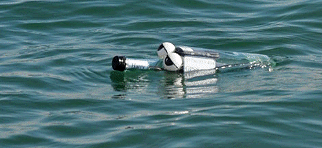 The winds continued to blow inshore, days after he landed on Wednesday 13th July, and his GPS tracker continued
to work for a few days, reporting the same position. He may have moved since then.
We thought he might still be there, near Bouldnor-Cranmore-Hamstead.
See the detailed
Ordnance Survey map
of where Harry landed:
on google maps, it is
here.
The winds continued to blow inshore, days after he landed on Wednesday 13th July, and his GPS tracker continued
to work for a few days, reporting the same position. He may have moved since then.
We thought he might still be there, near Bouldnor-Cranmore-Hamstead.
See the detailed
Ordnance Survey map
of where Harry landed:
on google maps, it is
here.
 That last reported position seems to be near rocks,
at the western edge of the beach. Robin's first guess was that Harry may have nestled up against the disused pier.
This spot might be reached from the east: a footpath down from Hamstead,
a walk of about 1000 yards along the beach. Alternatively, maybe a mile walk from the west, from Bouldnor, near Yarmouth.
Low tide may be the best time to look for Harry: times are
here.
If he broke his nose on rocks and sank, he might then be seen. Beach access might also be easier at low tide.
For those with a GPS, the last reported position was lat/lon 50.71684 -1.45513 - in decimal degrees,
or - if your prefer - N 50 43.01 W 1 27.3078 in degrees and minutes.
That last reported position seems to be near rocks,
at the western edge of the beach. Robin's first guess was that Harry may have nestled up against the disused pier.
This spot might be reached from the east: a footpath down from Hamstead,
a walk of about 1000 yards along the beach. Alternatively, maybe a mile walk from the west, from Bouldnor, near Yarmouth.
Low tide may be the best time to look for Harry: times are
here.
If he broke his nose on rocks and sank, he might then be seen. Beach access might also be easier at low tide.
For those with a GPS, the last reported position was lat/lon 50.71684 -1.45513 - in decimal degrees,
or - if your prefer - N 50 43.01 W 1 27.3078 in degrees and minutes.
searches: Roger searched 1.75 miles of beach at low tide on afternoon of 26th July, between
Bouldnor and Hamstead; found nothing; very little weed for a broken Harry to hide in. Maybe Harry
moved eastward, freed by strong wind and waves to east, on 15th and 16th.
On Thursday 28th Roger searched over two miles of beach from Hamstead to the mouth of the Newtown Estuary: no find.
Roger is 80% certain he would have seen Harry, if he were on the beach.
Thanks for the searching and photos Roger. Maybe Harry is even further east, such as the east
of Newtown Bay, or even as far as Thorness Bay - where Flashing Fred turned up ???
See the
Ordnance Survey map
for these places in detail.
other older news ...

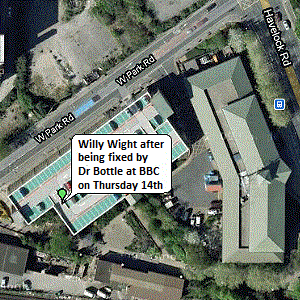 Willy Wight found again !
Tracy and Simon found Willy on the beach on Wednesday (see left), called Robin, then looked after Willy until given to the BBC.
Robin understands they were also interviewed on the radio. Many Thanks Tracy and Simon.
The BBC's Dr Bottle fixed a broken wire and re-charged Willy's battery.
At 2200 BST (2100 GMT), Willy was
re-launched, north of Cowes, Isle of Wight, just as the tide was changing.
Last received position was 0415am Saturday (China "11:15") between Calshot and Hill Head on mainland,
here.
Before this, since his launch at 10pm Friday, Willy had surfed the tide from Cowes, down to Hurst Castle and back.
Willy was found
here,
wrecked on rocks near Titchfield Haven, west of Hill Head, Saturday evening,
by a kind gentleman.
You can also see the spot on
Streetview.
He left Willy on the doorstep of the Visitor Centre
here
and emailed Robin.
Robin spoke to Caroline who held Willy until the BBC collected him, and returned him home to Robin.
Willy has a broken nose and wet electronics, so is unlikely to try sailing again for a while :-)
Willy Wight found again !
Tracy and Simon found Willy on the beach on Wednesday (see left), called Robin, then looked after Willy until given to the BBC.
Robin understands they were also interviewed on the radio. Many Thanks Tracy and Simon.
The BBC's Dr Bottle fixed a broken wire and re-charged Willy's battery.
At 2200 BST (2100 GMT), Willy was
re-launched, north of Cowes, Isle of Wight, just as the tide was changing.
Last received position was 0415am Saturday (China "11:15") between Calshot and Hill Head on mainland,
here.
Before this, since his launch at 10pm Friday, Willy had surfed the tide from Cowes, down to Hurst Castle and back.
Willy was found
here,
wrecked on rocks near Titchfield Haven, west of Hill Head, Saturday evening,
by a kind gentleman.
You can also see the spot on
Streetview.
He left Willy on the doorstep of the Visitor Centre
here
and emailed Robin.
Robin spoke to Caroline who held Willy until the BBC collected him, and returned him home to Robin.
Willy has a broken nose and wet electronics, so is unlikely to try sailing again for a while :-)
Robin was interviewed again on the radio, at 0725 on Wednesday 13th July, and suggested
the BBC give people like Liz a box of chocolates :-)
 Dolly Dorset was lost at sea - now on the Isle of Wight ? : Dolly had a lovely voyage on Monday, before beaching at Boscombe, near Bournemouth, at 6pm
and being found by Liz
- details are below.
Dolly was due to be re-launched at 1015am on Wednesday but then we saw the tracking had stopped - for the first time in weeks.
Robin tried to contact Tim at 10am, but was unable to.
He did eventually manage to contact
the BBC, but by then it was too late and Dolly had been launched. At 1205 Robin managed to contact Tim,
who tried to find Dolly, remembering where he dropped her -
but sadly, Dolly could not be found :-(
See "lessons learned" below. Our best guess is that Dolly was caarried by tide and wind, to land on the Isle of Wight,
somewhere between The Needles and St Catherine's Point.
Dolly Dorset was lost at sea - now on the Isle of Wight ? : Dolly had a lovely voyage on Monday, before beaching at Boscombe, near Bournemouth, at 6pm
and being found by Liz
- details are below.
Dolly was due to be re-launched at 1015am on Wednesday but then we saw the tracking had stopped - for the first time in weeks.
Robin tried to contact Tim at 10am, but was unable to.
He did eventually manage to contact
the BBC, but by then it was too late and Dolly had been launched. At 1205 Robin managed to contact Tim,
who tried to find Dolly, remembering where he dropped her -
but sadly, Dolly could not be found :-(
See "lessons learned" below. Our best guess is that Dolly was caarried by tide and wind, to land on the Isle of Wight,
somewhere between The Needles and St Catherine's Point.
First launch of the three bottles on Monday 11th July:
The three GPS bottles were launched by Steve, talking live on Radio Solent, early on Monday 11th July:
Dolly south of Christchurch at 0730 BST (0630 GMT),
Willy at 0755 BST near Yarmouth, Isle of Wight, and Harry, south of Lepe at about 0830 BST.
Hamble. BBC Radio Solent have the "bottle battle" on their web site, and the new, simpler page
is where are the BBC bottles ? - for you to see where they are.
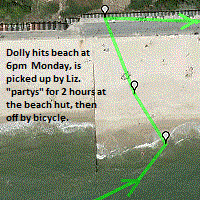 Dolly's voyage on Monday :
Dolly's voyage on Monday :
 Dolly Dorset, launched at 730am Monday, did a round trip, moving with the tide, but carried to the beach at Boscombe, near Bournmouth, by an inshore breeze.
She arrived on the beach at about 6pm, and within a few minutes was found by a Liz, the kind person who 'phoned
Robin. She arranged for Dolly to be kept safely overnight, awaiting collection by "Dr Bottle" from
BBC Radio Solent. This was done, and I understand Liz was interviewed on the Breakfast programme. Many Thanks Liz ! :-)
Dolly Dorset, launched at 730am Monday, did a round trip, moving with the tide, but carried to the beach at Boscombe, near Bournmouth, by an inshore breeze.
She arrived on the beach at about 6pm, and within a few minutes was found by a Liz, the kind person who 'phoned
Robin. She arranged for Dolly to be kept safely overnight, awaiting collection by "Dr Bottle" from
BBC Radio Solent. This was done, and I understand Liz was interviewed on the Breakfast programme. Many Thanks Liz ! :-)
Dolly may have had comfortable accomodation in the middle of Bournmouth on Monday night, but Harry and Willy had to "rough it"
on the beach: Harry near Leonard's Grange near Lepe - as Robin's DRIFT computer model had predicted, and
Willy west of Yarmouth on the Isle of Wight. Harry was stuck in the mud at Lepe, and Willy was waiting for someone
to find him on Norton Beach, IoW (now found and re-launched!)
Harry eventually broke free from the mud near Lepe, sailed out east of Cowes,
then crept back south along the coast to the beach near Cranmore, IoW early Wednesday morning - please help us find him.
Robin and his wife June had delivered the three bottles to Steve on the Sunday including the "Dr Bottle" kit:
electric meter, battery charger, and a damp towel - to keep the bottles cool if they are in the sun but not in the water
for a long rest.
When Robin and June returned home, they found that only the Dolly
map link worked: the
Harry
and
Willy
mapping websites were down. Robin immediately
emailed his friends in Shenzhen,China,
and they were working again before the launch on Monday morning.
Before meeting Steve, near the Hamble, Robin and June picked up "Flashing Fred" who had beached himself up at Lepe.
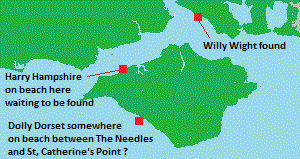 We are now all waiting to hear where the bottles will be found: After their sea trial, the bottles had been left running
- and do work for a few days, before the batteries fail at night - although it seems, when the sun comes out,
they charge up enough to report their position. We added the agreed labels, and also managed to squeeze in
the BBC Radio Solent logo on the sides, and the name on the "head" - not just in the neck. The labels include Robin's home
and mobile 'phone numbers.
Flashing Fred first turned up on a beach at Thorness Bay on the Isle of Wight.
Thanks for the email and photo Bill :-) Fred then sailed on to Lepe, on the mainland. Thanks Nick ! :-)
We are now all waiting to hear where the bottles will be found: After their sea trial, the bottles had been left running
- and do work for a few days, before the batteries fail at night - although it seems, when the sun comes out,
they charge up enough to report their position. We added the agreed labels, and also managed to squeeze in
the BBC Radio Solent logo on the sides, and the name on the "head" - not just in the neck. The labels include Robin's home
and mobile 'phone numbers.
Flashing Fred first turned up on a beach at Thorness Bay on the Isle of Wight.
Thanks for the email and photo Bill :-) Fred then sailed on to Lepe, on the mainland. Thanks Nick ! :-)
lessons learned ...
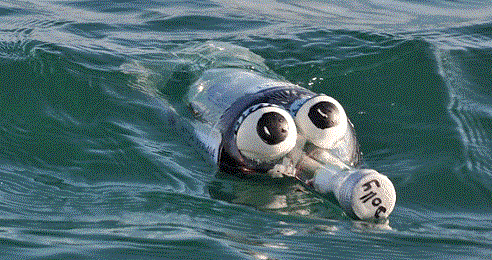 Hindsight is a wonderful thing: we all make mistakes - including Robin !
Sadly, nobody checked if the tracking was working before Dolly was dropped in the sea again, on her second voyage.
Hindsight is a wonderful thing: we all make mistakes - including Robin !
Sadly, nobody checked if the tracking was working before Dolly was dropped in the sea again, on her second voyage.
Here is a possible "procedure" that might be followed in future in any similar project:
1. After collecting a bottle from a finder, thanking them, contact Robin.
Simple checks can be done, like holding the bottle upright and looking for water inside.
If there is water inside - which is unlikely - unscrew the top and empty it out carefully.
2. When Dr Bottle attends to the bottle (whoever has the kit including meter, charger, etc), contact Robin.
Confirm that everything is working, before and after charging.
If Dr Bottle does not have
access to the Net, to click on the tracking page
here, then Robin can do that.
3. When bottle is ready to launch, discuss where from and when with Robin.
We can make sure the bottle is launched somewhere sensible, allowing for tide and wind, so they do not beach immediately.
4. Before actually going live on the radio, and launching the bottle, check the tracking is working - check with Robin.
Ideally you should note the exact place of drop with a GPS or smartphone, and when - but Robin can do this.
Robin can also communicate directly with the bottle GPS tracker via text messages - not just the web based tracking.
5. Tell Robin when you have launched the bottle. He can then note the exact place and time.
6. Make a note of this page, so you know what it's all about, and where to get the latest news.
important information for Dr Bottle ...
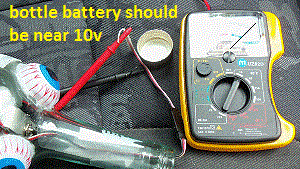
 If we are very lucky, then all three bottles may continue to work for days, weeks, or even longer.
However, it is more likely that after a few days, the main 10v battery will start to go flat,
because the solar cells are not getting enough sunshine to keep the bottle running overnight.
If we are very lucky, then all three bottles may continue to work for days, weeks, or even longer.
However, it is more likely that after a few days, the main 10v battery will start to go flat,
because the solar cells are not getting enough sunshine to keep the bottle running overnight.
Maybe a "Dr Bottle" from the BBC, can visit any bottle that gets washed up on a beach, and check
it out, before it is put back in the sea. If he unscrews the cap, he should be able to pull out a
little connector on the end of three wires. Only the white and black are important: white=10v
and black=0v. A matching socket is in the Dr Bottle toolkit, and a meter set to 10v scale.
If the battery is fully charged, the needle will go right across to 10v, as seen on the left.
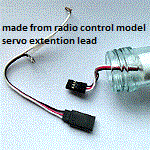 If the voltage has dropped to less than 8v, then the bottle may not last another day: there
will not be enough power to operate the GPS tracker. The same connector can be used to charge
up the bottle's 10v battery, if connected to a suitable "fast charger", similar to those used
by radio controlled model aircraft, boat and car enthusiast. The battery is an 8 cell 9.6v 2300mAH
NiMHd pack, and can be rapid charged from completely flat in an hour. When fully charged, the
battery will normally be much higher than it's nominal 9.6v - typically more than 10v, and possibly 11v.
If the voltage has dropped to less than 8v, then the bottle may not last another day: there
will not be enough power to operate the GPS tracker. The same connector can be used to charge
up the bottle's 10v battery, if connected to a suitable "fast charger", similar to those used
by radio controlled model aircraft, boat and car enthusiast. The battery is an 8 cell 9.6v 2300mAH
NiMHd pack, and can be rapid charged from completely flat in an hour. When fully charged, the
battery will normally be much higher than it's nominal 9.6v - typically more than 10v, and possibly 11v.
It is important that a suitable fast charger is used, or the battery inside the bottle could be damaged.
For those making up their own "Dr Bottle" equipment, they will find the parts in a local radio control
model shop. A servo extention lead (£2 or £3 ?) can be cut in half and the "socket" end used as
the adapter to the bottle lead. The same shop should sell a fast-charger (£20 to £30 max - maybe much less ?),
suitable for a 9.6v NiMHd battery. A cheap (£10?) multimeter can be got from somewhere like Maplins.
But I'm guessing whoever reads this, may have some of these things already :-)
Robin will deliver a suitable fast charger with the three bottles on Sunday. It can operate
from either a car (or boat?) 12 volt supply, or normal 240v mains. Robin
tested it on Harry, who had dropped below 9v. He simply connected the charger,
and it fast charged Harry up to 11v within 30 minutes. The charger switches off the fast charge
automatically, and on to "trickle charge" - shown by a green LED.
earlier development, testing, sea trials, etc ...

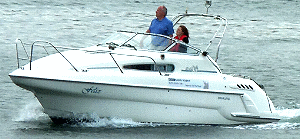 Our first sea test on Tuesday 28th June was a great success - given us confidence that the system should work
when the bottles are cast adrift off the south coast. Seven years ago we tracked the bottles for months,
across from Ramsgate to France, and as far as Den Helder in Holland. But today's technical solution
is very different and needs to be tested.
Our first sea test on Tuesday 28th June was a great success - given us confidence that the system should work
when the bottles are cast adrift off the south coast. Seven years ago we tracked the bottles for months,
across from Ramsgate to France, and as far as Den Helder in Holland. But today's technical solution
is very different and needs to be tested.
Robin and his friend Roy spent most of the time in the excellent little French Patissere Mons Hulot,
where there was WiFi access, and tracked the bottles on Robin's laptop. They spoke by mobile 'phone to the two testers,
who collected the bottles, in their "Dr Bottle Box", and sailed down to the Solent, where they were dropped
in the water. Robin also exchanged text messages with the GPS trackers.
Dolly and Willy worked very well, but Harry - according to the tracker - had never left Robin's home. Tests that evening indicate
that there is a bad connection inside Harry, and so his bottle will be broken open, the problem fixed,
then resealed to join the other two now floating in Robin's pool to see how long they will run.
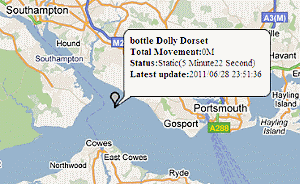
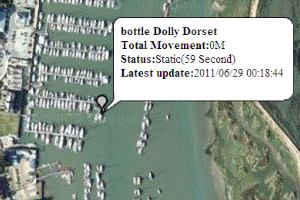 Here you see two pictures from the experimental web based tracking: on the left is where the three bottles,
tied on a length of string, were dropped into the water. It is also where "Fred" was released at about 1630.
Note that times on the map labels are Chinese time, UK+7 hours ! :-)
Here you see two pictures from the experimental web based tracking: on the left is where the three bottles,
tied on a length of string, were dropped into the water. It is also where "Fred" was released at about 1630.
Note that times on the map labels are Chinese time, UK+7 hours ! :-)
On the right is what we saw when the boat stopped in the Hamble, on the way back, to top up with fuel.
Our plan now is to open up Harry, fix his problem, glue his bottle back together, and for the three
bottles to be left running in Robin's pool, to see how many days they continue running - with help with
what little sun they get. If they are still running after several days, measuring the battery voltage
should tell us how much longer they would last.

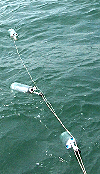
We can then concentrate on the supporting (much simpler) web site page, for the public to track the bottles,
before the bottles are handed over for their much longer voyage at sea.
(the simpler page
is where are the bottles... ?)
latest news on Harry ... We can confirm, as expected, that a well-glued bottle is probably impossible
to open without breaking it - so another 1.5 litres of wine must now be consumed. We found no wiring problem,
so it looks as if the battery voltage had dropped too much for the tracker to switch on. Harry was recharged,
and it was discovered that a wrong charging resistor value had been used, resulting in 30mA drain from
the main battery instead of nearer 9mA - to trickle charge the PICAXE timer battery. This was corrected
and the new bottle sealed with just outside selotape. Harry is now in the pool with the other two.
Lets hope the selotape keeps him sealed !
Here are some more piccys of the bottles during their sea trial, including "Flashing Fred" before he was dropped in.
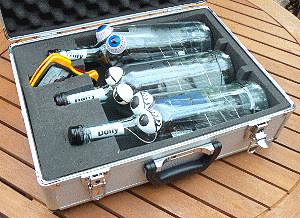
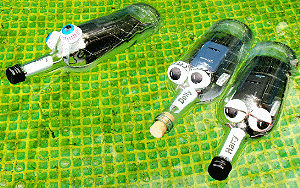 three bottles were taken to the seaside: "Harry", "Dolly" and "Willy".
Ping pong ball made the "eyes" :-)
The "Dr Bottle" box will eventually have a suitable "toolkit" and instructions, should "health visits" be needed, to "check the patient"
(battery voltage) and may give them "medicine" (a quick charge of electricity) - or maybe press their reset button to re-set the timer.
three bottles were taken to the seaside: "Harry", "Dolly" and "Willy".
Ping pong ball made the "eyes" :-)
The "Dr Bottle" box will eventually have a suitable "toolkit" and instructions, should "health visits" be needed, to "check the patient"
(battery voltage) and may give them "medicine" (a quick charge of electricity) - or maybe press their reset button to re-set the timer.
extra bottles with flashing lights left floating ? : We just had time to make one "flashing bottle" - but Fred only has a weak yellow flashing LED.
It seems our only safe colour is yellow/amber, since white, red and green are spoken for. e.g. white for a north-marker bouy.
Finding bright, yellow flashing lights will take longer - probably on e-bay :-)
Robin's idea for the sea trial was that - in addition to the
three GPS bottles that he brings back home, he might leave several smaller bottles with just flashing lights in - to be left floating
in the middle of the Solent. This is to find out if they could be seen from the shore at dusk or night.
 They probably will not be seen,
since the lights will be no brighter than those on a bicycle, and probably a lot dimmer - the LEDs you get in electronics. We might also
put a garden solar lamp in a bottle. If, as expected, they cannot be seen, we need not waste our time on flashing lights. BUT, if they can
- it may open up the chance of having the public track our bottles from land - or have extra (much cheaper) bottles, with messages in
- and flashing lights to aid their being seen when away from the shore.
For those thinking of doing the work for Robin ...
The standard sized bottle here was cut, using the method shown
further below, under "the bottles themselves", then a cheap cycle lamp was held with a bit of scrap wood. Ballast is needed - two larger
battery cells, to give long life ? The whole process, including temporary sealing with outside selotape, took just 15 minutes.
The clever bit would be how to use a stick through the top, to switch on and off the light. I'm sure someone can do this better than
I did here ;-)
They probably will not be seen,
since the lights will be no brighter than those on a bicycle, and probably a lot dimmer - the LEDs you get in electronics. We might also
put a garden solar lamp in a bottle. If, as expected, they cannot be seen, we need not waste our time on flashing lights. BUT, if they can
- it may open up the chance of having the public track our bottles from land - or have extra (much cheaper) bottles, with messages in
- and flashing lights to aid their being seen when away from the shore.
For those thinking of doing the work for Robin ...
The standard sized bottle here was cut, using the method shown
further below, under "the bottles themselves", then a cheap cycle lamp was held with a bit of scrap wood. Ballast is needed - two larger
battery cells, to give long life ? The whole process, including temporary sealing with outside selotape, took just 15 minutes.
The clever bit would be how to use a stick through the top, to switch on and off the light. I'm sure someone can do this better than
I did here ;-)
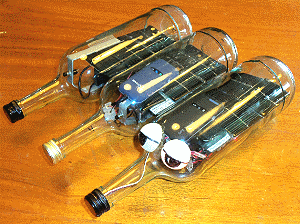 use of GSM air time : Today Robin found out how to call T-Mobile, armed with his credit card and the
SIM card numbers, and find out how much "top-up" had been used so far. It seems, if updating every 15 minutes, they cost
about £1/day to run. He topped them all up to £50 - which should be plenty. If we need more, we can top them up later.
use of GSM air time : Today Robin found out how to call T-Mobile, armed with his credit card and the
SIM card numbers, and find out how much "top-up" had been used so far. It seems, if updating every 15 minutes, they cost
about £1/day to run. He topped them all up to £50 - which should be plenty. If we need more, we can top them up later.
 balance: The picture on the right shows the "float test" of the "Dolly Dorset" bottle, even lighter batteries (220gm), 5 solar cells,
the GT02 GPS tracker (top front), and 200gm of lead at back, to get top above water. It has all been a very "tight fit",
but we still have spare room, and can add more ballast (or batteries) at back to bring the "nose" even higher - and safer above the water.
e.g. that picture on the right, with the heavier batteries (+90gm).
balance: The picture on the right shows the "float test" of the "Dolly Dorset" bottle, even lighter batteries (220gm), 5 solar cells,
the GT02 GPS tracker (top front), and 200gm of lead at back, to get top above water. It has all been a very "tight fit",
but we still have spare room, and can add more ballast (or batteries) at back to bring the "nose" even higher - and safer above the water.
e.g. that picture on the right, with the heavier batteries (+90gm).
simpler design - no timer? : Testing of the Dolly Dorset tracker, in past few days, shows that the solar panel may be able to keep the system running for several weeks,
with it switched on continuously - and without the complication of extra batteries and electronics. So at least one bottle tested at sea soon, will probably be like this.
KISS = "Keep It Simple Stupid" - an old engineering term :-) However - today Robin saw that, when the new tracker is not moving (as on
the window sill) it is clever enough to reduce power consumption to 6mA - but the slightest movement brings up the power to the normal 40mA+.
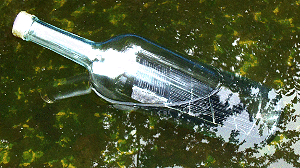 labels: We can now see that the main bottle label, wrapped inside the bottle, is almost entirely under the water, with only
the front top corner visible. This label is almost A4 width (20cm) by 16.6cm around the bottle. There is room for a smaller label
to wrap inside the neck of the bottle (7cm wide). This is probably where we will put the (short) name. e.g. "Dolly" (Dolly Dorset)
to increase chance of it being read, when in the water, from a reasonable distance (10 yards unaided, more than 50 yards with binoculars?)
There is plenty of room on the main label for whatever information needs to be on the bottle, if it is lifted out of the water, or found on a beach by acccident.
"Accidental finders" are those we should have in mind when designing the labels.
labels: We can now see that the main bottle label, wrapped inside the bottle, is almost entirely under the water, with only
the front top corner visible. This label is almost A4 width (20cm) by 16.6cm around the bottle. There is room for a smaller label
to wrap inside the neck of the bottle (7cm wide). This is probably where we will put the (short) name. e.g. "Dolly" (Dolly Dorset)
to increase chance of it being read, when in the water, from a reasonable distance (10 yards unaided, more than 50 yards with binoculars?)
There is plenty of room on the main label for whatever information needs to be on the bottle, if it is lifted out of the water, or found on a beach by acccident.
"Accidental finders" are those we should have in mind when designing the labels.
 electronics: Snoopy has been renamed "Harry" and his bits (on left) have been "tidied up" (see right) and squeezed into a bottle.
Float tests looked just the same as "Dolly" above, and he needs plenty of ballast. Harry uses the "Plan B" of the relay operating the
switch. Extra micro-switches and Acoms AS-17 servos arrived today - thanks to rapid delivery of Maplins and JK-RC.
electronics: Snoopy has been renamed "Harry" and his bits (on left) have been "tidied up" (see right) and squeezed into a bottle.
Float tests looked just the same as "Dolly" above, and he needs plenty of ballast. Harry uses the "Plan B" of the relay operating the
switch. Extra micro-switches and Acoms AS-17 servos arrived today - thanks to rapid delivery of Maplins and JK-RC.
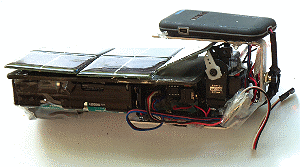 The UK supplier of electronic versions had problems - hence "plan B". These servos consume less current
than many servos. Of course, it is possible that we do not need the timers at all, for this particular project, but the electronic
timer may be needed - according to how sunny it is when the bottles are sailing :-)
The UK supplier of electronic versions had problems - hence "plan B". These servos consume less current
than many servos. Of course, it is possible that we do not need the timers at all, for this particular project, but the electronic
timer may be needed - according to how sunny it is when the bottles are sailing :-)
You can set the "reset timer" push button at the front - reachable with a pencil. There is also a monitor lead,
that runs up the neck of the bottle, for checking 5v and 10v battery voltages - and re-charging before launch if needed.
So, after glueing the ends on the bottles, we may not need to open them.
new trackers ordered: Two new GT02A trackers have been ordered, to see if they are available in time.
It's possible they can be used to avoid Robin having to use the two prototype GT02 in "Harry" and "Willy".
web based tracking: "Snoopy" has been renamed to "Harry". The big step forward was last Tuesday, when Robin's friends in Shenzhen,China fixed a problem so we could
track the new GT02A tracker that arrived on the 16th. This can be tracked on
bottle Dolly Dorset, with it's website now working OK.
We are now experimenting with the "historical" web pages - see the new links below under "maps for tracking the bottles".
On the left is the system for the first bottle, that has already been running for a number of days,
with it's web based tracking on
the Harry map (was Snoopy).
Don't be dismayed by the untidy appearance of the electronics: that's just a "breadboard" version while we test the design
- particularly making sure
the five solar cells can keep it running continuously. You can't see the solar cells because they are facing the window.
The radio control servo in the foreground, with a microswitch glued to it, was to be replaced by an electronic switch
- which will be neater and consume less power - maybe only 5mA. This switch goes on for 2 minutes every 20 minutes. It is controlled by the PICAXE
based timer near the back of Shaun the sheep. Plan "B" is to use a neater servo-microswitch assembly.
Mascots
Those mascots of "Snoopy", "Tweetypie" and "Shaun" will change, following suggestions from the BBC. Robin is on the lookout for suitable
plastic mascots - if we use them. We may just limit ourselves to painting a face, or at least two eyes on the front of the bottle :-)
first sea tests on Tuesday 28th June: These tests are intended to:
- see how well the GPS tracking of the bottles works - in realistic sea conditions, including in The Solent.
- see how the bottles "bob up and down" to see if we should adjust ballast, etc.
- see how well they can be seen when in the sea, from a distance, including reading labels, and maybe flashing lights (but dusk needed?)
- familiarise the BBC with the bottles and discover snags we'd not thought of.
- See "extra bottles with flashing lights left floating ?" above.
Robin is hopeful to have three bottles working, and ready to be tested in the sea on the afternoon of Tuesday 28th June. Here are
some notes on current thoughts: The bottles should switch on and send their positions to the web site links above, every 20 minutes,
on the hour, at 20 past, and 20 to. They should switch on within a few seconds of this time. Some may be on all the time,
and these should update the web site(s) every 15 minutes.
After the tests, expected to last no more than an hour or two, Robin will take them back home, for safe keeping until
they are handed over for the actual launch date(s). It is anticipated that changes may be needed, including simple things
like ballast, to position the bottle in the water, labels, etc. The main purpose is to give us confidence that
the bottle tracking will work OK, when the bottles are far out into Southampton Water and the Solent - with waves
between the bottles and the shore based T-Mobile 'phone network. The old bottles of seven years ago worked OK,
but there are many differences in these new bottle electronics, mobile 'phone network (was O2) and web tracking.
The "testers" will be in a boat, and Robin will be on shore, with mobile 'phone and Internet access.
Robin will be in contact with the testers on his mobile 'phone and maybe PMR radio.
Other people with Internet access could be useful - to check those bottle tracking pages update OK.
The ideal facility is a smart phone with internet access - maybe the testers in the boat will have one
- if it too is in mobile 'phone coverage :-)
After a brief chat and explanations on the shore, the testers will take the bottles out in a boat.
They will drop them in the water, and move the boat at least 10 yards away, a few minutes before
their "switch on" time. After the "switch off", two minutes later, they can recover the bottles
and move on to the next test position. So, it should be possible to sail their boat for at least 10 minutes,
maybe 15, to the next position, before the bottles are dropped in the water again.
If there are big problems, we might cut the trial short. The length of Southampton Water is roughly 6 miles, with another 2 miles
to the middle of the Solent. If their boat can make 17 knots, that's roughly 4.5 miles in 15 minutes, which should be OK.
Robin needs to get home for italian classes at his house before 1900, so that means leaving Southampton in the rush hour after 1700 :-)
Maybe a length of string will be useful: to string the bottles together, so they can more easily and quickly recovered
from the water, before moving on to the next position. It might be a bit too risky to tow them at 17 knots :-)
We are now testing the facility for the web tracking to show where the bottles have been.
Sorry it's all in Chinese time, 7 hours ahead of us :-)
the bottles themselves ...
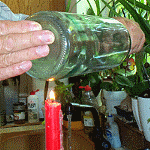 Seven years ago, the only bottles we could find big enough to hold the solar panel and
other bits, were the clear 1.5 litre Frascati wine bottles from the italian shop in Maidenhead. We still found fitting everything
into a smaller bottle a challenge, so we've used 1.5 litre bottles of Souve from Tesco.
First we consume the contents - the most enjoyable bit :-) Next we put them in a bucket of cold water overnight,
to soak the labels off. They are full of water to keep them covered. Then, the water is emptied out and the interesting
job begins - of cutting the bottom off cleanly. For this you need a small glass-cutter, a lit candle, and a running tap of cold water.
Stand the empty bottle on a flat surface, like a table, and support the glass-cutter so it is about 3.5cm or more
above the surface. Carefully scratch all the way around the bottle - this is where it should break.
Lay the bottle sideways on the table to see where it naturally rolls to: few bottles are perfectly balanced.
Use a marker pen to "remember" where the bottom is. Use the pen to draw a line across the scratch, so it is easier
to match up the two halves after they break appart.
Seven years ago, the only bottles we could find big enough to hold the solar panel and
other bits, were the clear 1.5 litre Frascati wine bottles from the italian shop in Maidenhead. We still found fitting everything
into a smaller bottle a challenge, so we've used 1.5 litre bottles of Souve from Tesco.
First we consume the contents - the most enjoyable bit :-) Next we put them in a bucket of cold water overnight,
to soak the labels off. They are full of water to keep them covered. Then, the water is emptied out and the interesting
job begins - of cutting the bottom off cleanly. For this you need a small glass-cutter, a lit candle, and a running tap of cold water.
Stand the empty bottle on a flat surface, like a table, and support the glass-cutter so it is about 3.5cm or more
above the surface. Carefully scratch all the way around the bottle - this is where it should break.
Lay the bottle sideways on the table to see where it naturally rolls to: few bottles are perfectly balanced.
Use a marker pen to "remember" where the bottom is. Use the pen to draw a line across the scratch, so it is easier
to match up the two halves after they break appart.
 Now rotate the empty bottle over the candle, the flame just touching the scratch. The glass should feel hot within
a minute or two of this. Now quench the area in cold running water. Repeat this until the bottle falls appart. This should
only take you 5 or 10 minutes. Even if the break is not perfect - following the scratch - the two halves should match !
Use something like silican glue to join the two bits together - after you have inserted all the electronics - or whatever
you are putting inside the bottle. The glue could be what is used to assemble fish tanks, or something like
"Unibond multi repair 3 in 1 sealant, adhesive & filler - translucent".
Remember: you may find it almost impossible to break the seal, and may have to wreck a bottle to get inside.
Hence it may be a good idea to consume a few more bottles of wine, and have a few bottles spare :-)
Now rotate the empty bottle over the candle, the flame just touching the scratch. The glass should feel hot within
a minute or two of this. Now quench the area in cold running water. Repeat this until the bottle falls appart. This should
only take you 5 or 10 minutes. Even if the break is not perfect - following the scratch - the two halves should match !
Use something like silican glue to join the two bits together - after you have inserted all the electronics - or whatever
you are putting inside the bottle. The glue could be what is used to assemble fish tanks, or something like
"Unibond multi repair 3 in 1 sealant, adhesive & filler - translucent".
Remember: you may find it almost impossible to break the seal, and may have to wreck a bottle to get inside.
Hence it may be a good idea to consume a few more bottles of wine, and have a few bottles spare :-)
maps for tracking the bottles ...
To see where the bottles are now, click on
where are the bottles ?.
some other useful links ...
The GPS Bottle Story is here - starts like this page, but with full 2004 "message in a bottle" story.
Robin's GPS Software business site is
www.gpss.co.uk
and earlier TV publicity is on
AsOnTV.
Robin's charity site is
www.nhscare.info
- getting the NHS to obey the law on funding care homes. BBC Radio Solent publicity is on the
Press page.
bits used for each GPS bottle ...
Here is a checklist of bits, for anyone thinking of making their own GPS bottle, based on free advice and software from Robin:
- GPS tracker. e.g. Concox GT02. £50 to £200, depending on source.
- SIM card with sufficient top up for several weeks. e.g. T-Mobile £40 ?
- NiMHd battery pack. Typically 9.6v 3300mA. £20 ?
- Solar cells to charge battery £20 ?
- Digital timer to reduce power consumption. e.g. PICAXE + relay. £30 ?
- 1.5 Litre clear glass wine bottle. £7 ? - but somebody must drink contents :-)
i.e. in the ballpark of £200 of bits per bottle.
Problem is usually that bits are not always easily available, and/or their specification
and behaviour can be subject to change without warning - particularly if they come from China :-)


![]()
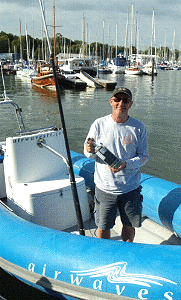
 from Robin :
Can it really be 7 years ago that the artist Layla Curtis launched those old GPS bottles into the sea ?
from Robin :
Can it really be 7 years ago that the artist Layla Curtis launched those old GPS bottles into the sea ?
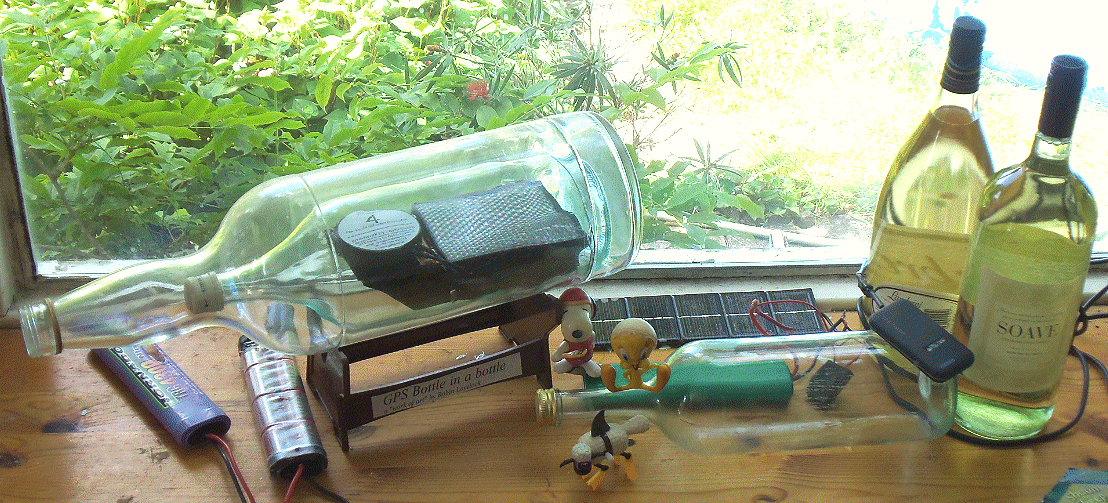
 Artist Layla knows Robin's "grumply old man"
view that much of modern "Art" and "Journalism" is really "Show Business" - maybe some "science" or "technology" is too ? :-)
Note that our bottles are now named "Dolly Dorset", "Harry Hampshire" and "Willy Wight" - and they have little faces, with bulgy eyes
- see left :-)
Artist Layla knows Robin's "grumply old man"
view that much of modern "Art" and "Journalism" is really "Show Business" - maybe some "science" or "technology" is too ? :-)
Note that our bottles are now named "Dolly Dorset", "Harry Hampshire" and "Willy Wight" - and they have little faces, with bulgy eyes
- see left :-)
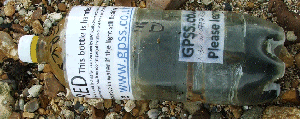 Now the more technical stuff: that bottle inside a bottle is Bottle #4 from the project of seven years ago - the full story is
Now the more technical stuff: that bottle inside a bottle is Bottle #4 from the project of seven years ago - the full story is
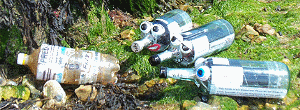 So this would extend
their working life to nearer four weeks. But we want those GPS bottles to keep working "forever" - or until they are found again.
Behind Snoopy and Tweety Pie, you can see a solar panel of 5 cells, being used for testing.
This only charges the battery at about 25mA, when the sun is out, but the timer means that the average battery drain
is probably 5mA
- so we may not need to add many solar cells. We can also reduce the position reporting to once an hour,
to reduce power drain even more.
So this would extend
their working life to nearer four weeks. But we want those GPS bottles to keep working "forever" - or until they are found again.
Behind Snoopy and Tweety Pie, you can see a solar panel of 5 cells, being used for testing.
This only charges the battery at about 25mA, when the sun is out, but the timer means that the average battery drain
is probably 5mA
- so we may not need to add many solar cells. We can also reduce the position reporting to once an hour,
to reduce power drain even more.


 The winds continued to blow inshore, days after he landed on Wednesday 13th July, and his GPS tracker continued
to work for a few days, reporting the same position. He may have moved since then.
We thought he might still be there, near Bouldnor-Cranmore-Hamstead.
See the detailed
The winds continued to blow inshore, days after he landed on Wednesday 13th July, and his GPS tracker continued
to work for a few days, reporting the same position. He may have moved since then.
We thought he might still be there, near Bouldnor-Cranmore-Hamstead.
See the detailed
 That last reported position seems to be near rocks,
at the western edge of the beach. Robin's first guess was that Harry may have nestled up against the disused pier.
This spot might be reached from the east: a footpath down from Hamstead,
a walk of about 1000 yards along the beach. Alternatively, maybe a mile walk from the west, from Bouldnor, near Yarmouth.
Low tide may be the best time to look for Harry: times are
That last reported position seems to be near rocks,
at the western edge of the beach. Robin's first guess was that Harry may have nestled up against the disused pier.
This spot might be reached from the east: a footpath down from Hamstead,
a walk of about 1000 yards along the beach. Alternatively, maybe a mile walk from the west, from Bouldnor, near Yarmouth.
Low tide may be the best time to look for Harry: times are

 Willy Wight found again !
Tracy and Simon found Willy on the beach on Wednesday (see left), called Robin, then looked after Willy until given to the BBC.
Robin understands they were also interviewed on the radio. Many Thanks Tracy and Simon.
The BBC's Dr Bottle fixed a broken wire and re-charged Willy's battery.
At 2200 BST (2100 GMT), Willy was
re-launched, north of Cowes, Isle of Wight, just as the tide was changing.
Last received position was 0415am Saturday (China "11:15") between Calshot and Hill Head on mainland,
Willy Wight found again !
Tracy and Simon found Willy on the beach on Wednesday (see left), called Robin, then looked after Willy until given to the BBC.
Robin understands they were also interviewed on the radio. Many Thanks Tracy and Simon.
The BBC's Dr Bottle fixed a broken wire and re-charged Willy's battery.
At 2200 BST (2100 GMT), Willy was
re-launched, north of Cowes, Isle of Wight, just as the tide was changing.
Last received position was 0415am Saturday (China "11:15") between Calshot and Hill Head on mainland,
 Dolly Dorset was lost at sea - now on the Isle of Wight ? : Dolly had a lovely voyage on Monday, before beaching at Boscombe, near Bournemouth, at 6pm
and being found by Liz
- details are below.
Dolly was due to be re-launched at 1015am on Wednesday but then we saw the tracking had stopped - for the first time in weeks.
Robin tried to contact Tim at 10am, but was unable to.
He did eventually manage to contact
the BBC, but by then it was too late and Dolly had been launched. At 1205 Robin managed to contact Tim,
who tried to find Dolly, remembering where he dropped her -
but sadly, Dolly could not be found :-(
See "lessons learned" below. Our best guess is that Dolly was caarried by tide and wind, to land on the Isle of Wight,
somewhere between The Needles and St Catherine's Point.
Dolly Dorset was lost at sea - now on the Isle of Wight ? : Dolly had a lovely voyage on Monday, before beaching at Boscombe, near Bournemouth, at 6pm
and being found by Liz
- details are below.
Dolly was due to be re-launched at 1015am on Wednesday but then we saw the tracking had stopped - for the first time in weeks.
Robin tried to contact Tim at 10am, but was unable to.
He did eventually manage to contact
the BBC, but by then it was too late and Dolly had been launched. At 1205 Robin managed to contact Tim,
who tried to find Dolly, remembering where he dropped her -
but sadly, Dolly could not be found :-(
See "lessons learned" below. Our best guess is that Dolly was caarried by tide and wind, to land on the Isle of Wight,
somewhere between The Needles and St Catherine's Point.
 Dolly's voyage on Monday :
Dolly's voyage on Monday :
 Dolly Dorset, launched at 730am Monday, did a round trip, moving with the tide, but carried to the beach at Boscombe, near Bournmouth, by an inshore breeze.
She arrived on the beach at about 6pm, and within a few minutes was found by a Liz, the kind person who 'phoned
Robin. She arranged for Dolly to be kept safely overnight, awaiting collection by "Dr Bottle" from
BBC Radio Solent. This was done, and I understand Liz was interviewed on the Breakfast programme. Many Thanks Liz ! :-)
Dolly Dorset, launched at 730am Monday, did a round trip, moving with the tide, but carried to the beach at Boscombe, near Bournmouth, by an inshore breeze.
She arrived on the beach at about 6pm, and within a few minutes was found by a Liz, the kind person who 'phoned
Robin. She arranged for Dolly to be kept safely overnight, awaiting collection by "Dr Bottle" from
BBC Radio Solent. This was done, and I understand Liz was interviewed on the Breakfast programme. Many Thanks Liz ! :-)
 Hindsight is a wonderful thing: we all make mistakes - including Robin !
Sadly, nobody checked if the tracking was working before Dolly was dropped in the sea again, on her second voyage.
Hindsight is a wonderful thing: we all make mistakes - including Robin !
Sadly, nobody checked if the tracking was working before Dolly was dropped in the sea again, on her second voyage.

 If we are very lucky, then all three bottles may continue to work for days, weeks, or even longer.
However, it is more likely that after a few days, the main 10v battery will start to go flat,
because the solar cells are not getting enough sunshine to keep the bottle running overnight.
If we are very lucky, then all three bottles may continue to work for days, weeks, or even longer.
However, it is more likely that after a few days, the main 10v battery will start to go flat,
because the solar cells are not getting enough sunshine to keep the bottle running overnight.
 If the voltage has dropped to less than 8v, then the bottle may not last another day: there
will not be enough power to operate the GPS tracker. The same connector can be used to charge
up the bottle's 10v battery, if connected to a suitable "fast charger", similar to those used
by radio controlled model aircraft, boat and car enthusiast. The battery is an 8 cell 9.6v 2300mAH
NiMHd pack, and can be rapid charged from completely flat in an hour. When fully charged, the
battery will normally be much higher than it's nominal 9.6v - typically more than 10v, and possibly 11v.
If the voltage has dropped to less than 8v, then the bottle may not last another day: there
will not be enough power to operate the GPS tracker. The same connector can be used to charge
up the bottle's 10v battery, if connected to a suitable "fast charger", similar to those used
by radio controlled model aircraft, boat and car enthusiast. The battery is an 8 cell 9.6v 2300mAH
NiMHd pack, and can be rapid charged from completely flat in an hour. When fully charged, the
battery will normally be much higher than it's nominal 9.6v - typically more than 10v, and possibly 11v.

 Our first sea test on Tuesday 28th June was a great success - given us confidence that the system should work
when the bottles are cast adrift off the south coast. Seven years ago we tracked the bottles for months,
across from Ramsgate to France, and as far as Den Helder in Holland. But today's technical solution
is very different and needs to be tested.
Our first sea test on Tuesday 28th June was a great success - given us confidence that the system should work
when the bottles are cast adrift off the south coast. Seven years ago we tracked the bottles for months,
across from Ramsgate to France, and as far as Den Helder in Holland. But today's technical solution
is very different and needs to be tested.

 Here you see two pictures from the experimental web based tracking: on the left is where the three bottles,
tied on a length of string, were dropped into the water. It is also where "Fred" was released at about 1630.
Note that times on the map labels are Chinese time, UK+7 hours ! :-)
Here you see two pictures from the experimental web based tracking: on the left is where the three bottles,
tied on a length of string, were dropped into the water. It is also where "Fred" was released at about 1630.
Note that times on the map labels are Chinese time, UK+7 hours ! :-)



 three bottles were taken to the seaside: "Harry", "Dolly" and "Willy".
Ping pong ball made the "eyes" :-)
The "Dr Bottle" box will eventually have a suitable "toolkit" and instructions, should "health visits" be needed, to "check the patient"
(battery voltage) and may give them "medicine" (a quick charge of electricity) - or maybe press their reset button to re-set the timer.
three bottles were taken to the seaside: "Harry", "Dolly" and "Willy".
Ping pong ball made the "eyes" :-)
The "Dr Bottle" box will eventually have a suitable "toolkit" and instructions, should "health visits" be needed, to "check the patient"
(battery voltage) and may give them "medicine" (a quick charge of electricity) - or maybe press their reset button to re-set the timer.
 They probably will not be seen,
since the lights will be no brighter than those on a bicycle, and probably a lot dimmer - the LEDs you get in electronics. We might also
put a garden solar lamp in a bottle. If, as expected, they cannot be seen, we need not waste our time on flashing lights. BUT, if they can
- it may open up the chance of having the public track our bottles from land - or have extra (much cheaper) bottles, with messages in
- and flashing lights to aid their being seen when away from the shore.
For those thinking of doing the work for Robin ...
The standard sized bottle here was cut, using the method shown
further below, under "the bottles themselves", then a cheap cycle lamp was held with a bit of scrap wood. Ballast is needed - two larger
battery cells, to give long life ? The whole process, including temporary sealing with outside selotape, took just 15 minutes.
The clever bit would be how to use a stick through the top, to switch on and off the light. I'm sure someone can do this better than
I did here ;-)
They probably will not be seen,
since the lights will be no brighter than those on a bicycle, and probably a lot dimmer - the LEDs you get in electronics. We might also
put a garden solar lamp in a bottle. If, as expected, they cannot be seen, we need not waste our time on flashing lights. BUT, if they can
- it may open up the chance of having the public track our bottles from land - or have extra (much cheaper) bottles, with messages in
- and flashing lights to aid their being seen when away from the shore.
For those thinking of doing the work for Robin ...
The standard sized bottle here was cut, using the method shown
further below, under "the bottles themselves", then a cheap cycle lamp was held with a bit of scrap wood. Ballast is needed - two larger
battery cells, to give long life ? The whole process, including temporary sealing with outside selotape, took just 15 minutes.
The clever bit would be how to use a stick through the top, to switch on and off the light. I'm sure someone can do this better than
I did here ;-)
 use of GSM air time : Today Robin found out how to call T-Mobile, armed with his credit card and the
SIM card numbers, and find out how much "top-up" had been used so far. It seems, if updating every 15 minutes, they cost
about £1/day to run. He topped them all up to £50 - which should be plenty. If we need more, we can top them up later.
use of GSM air time : Today Robin found out how to call T-Mobile, armed with his credit card and the
SIM card numbers, and find out how much "top-up" had been used so far. It seems, if updating every 15 minutes, they cost
about £1/day to run. He topped them all up to £50 - which should be plenty. If we need more, we can top them up later.
 balance: The picture on the right shows the "float test" of the "Dolly Dorset" bottle, even lighter batteries (220gm), 5 solar cells,
the GT02 GPS tracker (top front), and 200gm of lead at back, to get top above water. It has all been a very "tight fit",
but we still have spare room, and can add more ballast (or batteries) at back to bring the "nose" even higher - and safer above the water.
e.g. that picture on the right, with the heavier batteries (+90gm).
balance: The picture on the right shows the "float test" of the "Dolly Dorset" bottle, even lighter batteries (220gm), 5 solar cells,
the GT02 GPS tracker (top front), and 200gm of lead at back, to get top above water. It has all been a very "tight fit",
but we still have spare room, and can add more ballast (or batteries) at back to bring the "nose" even higher - and safer above the water.
e.g. that picture on the right, with the heavier batteries (+90gm).
 labels: We can now see that the main bottle label, wrapped inside the bottle, is almost entirely under the water, with only
the front top corner visible. This label is almost A4 width (20cm) by 16.6cm around the bottle. There is room for a smaller label
to wrap inside the neck of the bottle (7cm wide). This is probably where we will put the (short) name. e.g. "Dolly" (Dolly Dorset)
to increase chance of it being read, when in the water, from a reasonable distance (10 yards unaided, more than 50 yards with binoculars?)
There is plenty of room on the main label for whatever information needs to be on the bottle, if it is lifted out of the water, or found on a beach by acccident.
"Accidental finders" are those we should have in mind when designing the labels.
labels: We can now see that the main bottle label, wrapped inside the bottle, is almost entirely under the water, with only
the front top corner visible. This label is almost A4 width (20cm) by 16.6cm around the bottle. There is room for a smaller label
to wrap inside the neck of the bottle (7cm wide). This is probably where we will put the (short) name. e.g. "Dolly" (Dolly Dorset)
to increase chance of it being read, when in the water, from a reasonable distance (10 yards unaided, more than 50 yards with binoculars?)
There is plenty of room on the main label for whatever information needs to be on the bottle, if it is lifted out of the water, or found on a beach by acccident.
"Accidental finders" are those we should have in mind when designing the labels.
 electronics: Snoopy has been renamed "Harry" and his bits (on left) have been "tidied up" (see right) and squeezed into a bottle.
Float tests looked just the same as "Dolly" above, and he needs plenty of ballast. Harry uses the "Plan B" of the relay operating the
switch. Extra micro-switches and Acoms AS-17 servos arrived today - thanks to rapid delivery of Maplins and JK-RC.
electronics: Snoopy has been renamed "Harry" and his bits (on left) have been "tidied up" (see right) and squeezed into a bottle.
Float tests looked just the same as "Dolly" above, and he needs plenty of ballast. Harry uses the "Plan B" of the relay operating the
switch. Extra micro-switches and Acoms AS-17 servos arrived today - thanks to rapid delivery of Maplins and JK-RC.
 The UK supplier of electronic versions had problems - hence "plan B". These servos consume less current
than many servos. Of course, it is possible that we do not need the timers at all, for this particular project, but the electronic
timer may be needed - according to how sunny it is when the bottles are sailing :-)
The UK supplier of electronic versions had problems - hence "plan B". These servos consume less current
than many servos. Of course, it is possible that we do not need the timers at all, for this particular project, but the electronic
timer may be needed - according to how sunny it is when the bottles are sailing :-)
 Seven years ago, the only bottles we could find big enough to hold the solar panel and
other bits, were the clear 1.5 litre Frascati wine bottles from the italian shop in Maidenhead. We still found fitting everything
into a smaller bottle a challenge, so we've used 1.5 litre bottles of Souve from Tesco.
First we consume the contents - the most enjoyable bit :-) Next we put them in a bucket of cold water overnight,
to soak the labels off. They are full of water to keep them covered. Then, the water is emptied out and the interesting
job begins - of cutting the bottom off cleanly. For this you need a small glass-cutter, a lit candle, and a running tap of cold water.
Stand the empty bottle on a flat surface, like a table, and support the glass-cutter so it is about 3.5cm or more
above the surface. Carefully scratch all the way around the bottle - this is where it should break.
Lay the bottle sideways on the table to see where it naturally rolls to: few bottles are perfectly balanced.
Use a marker pen to "remember" where the bottom is. Use the pen to draw a line across the scratch, so it is easier
to match up the two halves after they break appart.
Seven years ago, the only bottles we could find big enough to hold the solar panel and
other bits, were the clear 1.5 litre Frascati wine bottles from the italian shop in Maidenhead. We still found fitting everything
into a smaller bottle a challenge, so we've used 1.5 litre bottles of Souve from Tesco.
First we consume the contents - the most enjoyable bit :-) Next we put them in a bucket of cold water overnight,
to soak the labels off. They are full of water to keep them covered. Then, the water is emptied out and the interesting
job begins - of cutting the bottom off cleanly. For this you need a small glass-cutter, a lit candle, and a running tap of cold water.
Stand the empty bottle on a flat surface, like a table, and support the glass-cutter so it is about 3.5cm or more
above the surface. Carefully scratch all the way around the bottle - this is where it should break.
Lay the bottle sideways on the table to see where it naturally rolls to: few bottles are perfectly balanced.
Use a marker pen to "remember" where the bottom is. Use the pen to draw a line across the scratch, so it is easier
to match up the two halves after they break appart.
 Now rotate the empty bottle over the candle, the flame just touching the scratch. The glass should feel hot within
a minute or two of this. Now quench the area in cold running water. Repeat this until the bottle falls appart. This should
only take you 5 or 10 minutes. Even if the break is not perfect - following the scratch - the two halves should match !
Use something like silican glue to join the two bits together - after you have inserted all the electronics - or whatever
you are putting inside the bottle. The glue could be what is used to assemble fish tanks, or something like
"Unibond multi repair 3 in 1 sealant, adhesive & filler - translucent".
Remember: you may find it almost impossible to break the seal, and may have to wreck a bottle to get inside.
Hence it may be a good idea to consume a few more bottles of wine, and have a few bottles spare :-)
Now rotate the empty bottle over the candle, the flame just touching the scratch. The glass should feel hot within
a minute or two of this. Now quench the area in cold running water. Repeat this until the bottle falls appart. This should
only take you 5 or 10 minutes. Even if the break is not perfect - following the scratch - the two halves should match !
Use something like silican glue to join the two bits together - after you have inserted all the electronics - or whatever
you are putting inside the bottle. The glue could be what is used to assemble fish tanks, or something like
"Unibond multi repair 3 in 1 sealant, adhesive & filler - translucent".
Remember: you may find it almost impossible to break the seal, and may have to wreck a bottle to get inside.
Hence it may be a good idea to consume a few more bottles of wine, and have a few bottles spare :-)